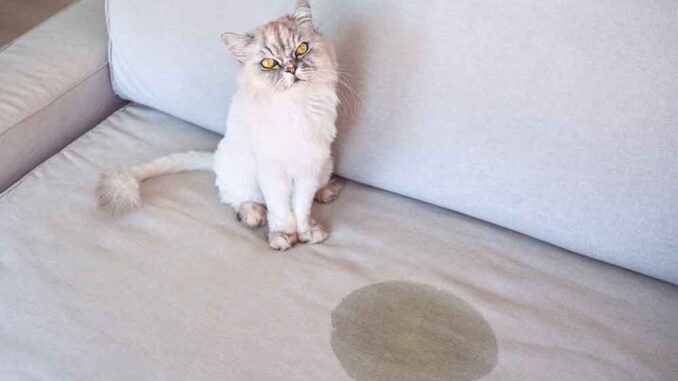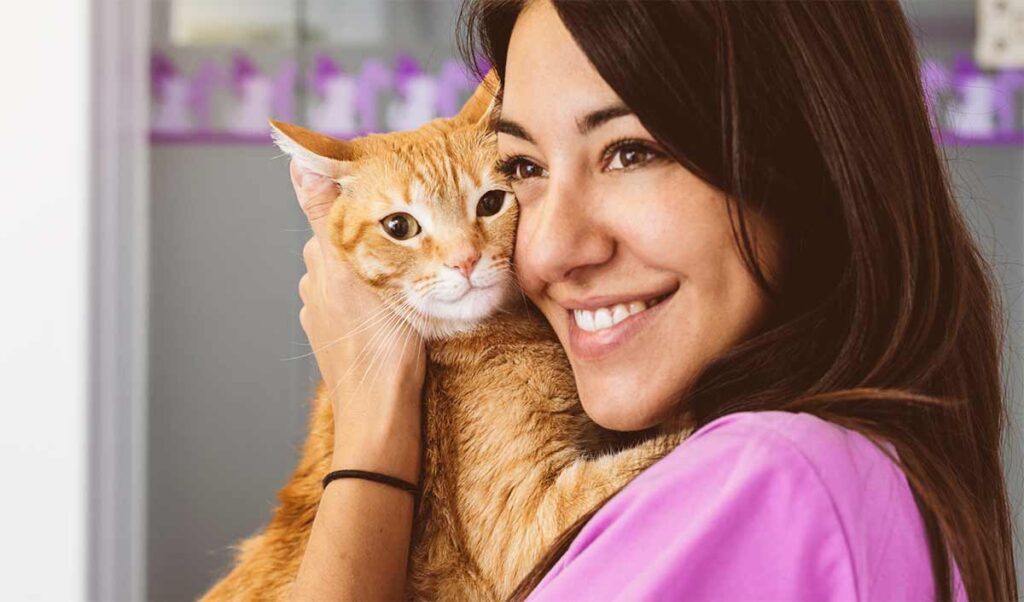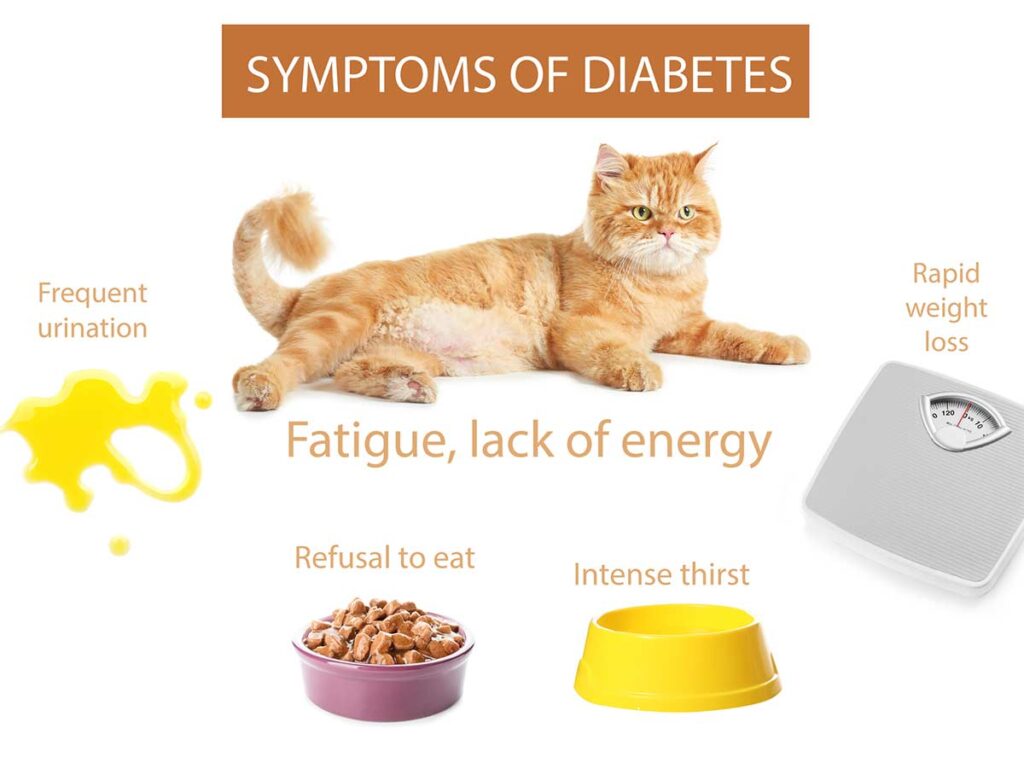
This article was updated on January 6th, 2023
Typically, healthy cats urinate 2-4 times a day but this frequency can be affected by several factors. Polyuria is a condition used to describe excessive urination which is interlinked to polydipsia or increased thirst. Excessive urination is one of the conditions that is often observed with elderly cats as they become older.
Why is your elderly cat urinating inside the house?
If your elderly cat is urinating in the house and forgetting the litter box, the reasons could be behavioral or medical. Whilst behavioral conditions are more common in younger cats, it’s important to rule out medical conditions, especially in elderly cats where these conditions become more common.
We have listed the most common reasons below:
Behavioral Reasons
There are several common factors that could create behavioral issues and lead to your old cat urinating in the wrong places: stress, litter box location, litter tray style and litter tray type, marking over old scents, feline dementia (cognitive dysfunction). Here are more details and recommendations:
- Stress: Just like humans or other animals, elderly cats tend to value their everyday routine more and more as they become older. Changes in their routine or their environment can create additional stress, which could lead to peeing inside the house. If your cat has experienced changes in their environment, try experimenting with setting up a regular routine to see if this can help reduce their stress.
- Litter box issues: As your cat ages, they can become stuck in their ways. If you’ve changed anything about their litter box, they may refuse to use it. In addition, cats will urinate elsewhere if they associate their litter tray with pain – either because of arthritis or because they had a urinary condition that made them uncomfortable. If your cat’s litter box is too dirty, too small or not located in the right place, your elderly cat may opt for other options. Remember that any disease causing increased urination will cause the tray to become dirtier sooner, so check the tray regularly or provide several. Consider changes or improvements to your old friend’s litter box quality to find out if this can help. You could also move the box to a better / quieter location – try placing it where they’ve been urinating Remember, your alderly cat may have arthritis, so check they can easily reach their tray, or place more than one to ensure they always have one nearby.
- Urine smells: try inspecting the house for old urine smells and marks, which could lead your cat to pee outside of the litter box (for example to mark their territory). Your cat may be able to detect smells that you can’t. A UV inspection flashflight such as this one (Amazon link) is relatively inexpensive and can work wonders to locate urine stains. If your cat is peeing outside of the litter box, chances are that you may need a UV flashlight anyway to find urine stains and keep your house clean.

You can also try changing the litter tray especially if it is wet all the time because this can be an indication that the cat does not want to use it anymore. Litter box should be appealing and placed at preferred location of cat.
Provide an indoor litter box as with the increase in age it becomes difficult for cats to go outside every time they have to pee. A possible reason could be stiffening of the joints which causes discomfort, weakness and decreased mobility and cat is unable to walk to the litter box.
Cognitive dysfunction In some cases, cats may ‘forget’ their litter training because of feline dementia – also caused ‘cognitive dysfunction’. Signs of cognitive dysfunction include excessive yowling, wandering, and lack of social interaction. Mental stimulation by increasing play time and interaction can help, and your veterinarian may be able to recommend medication or diet changes that will also help. View our other tips to take care of an elderly cat.
On the other hand, an elderly cat urinating in the house can also be a sign of a serious underlying health condition. We have listed below the possible diseases that are common in elderly cats and can cause excessive urination:
Chronic kidney disease
What is it? Chronic kidney disease (or ‘CKD’, ‘chronic renal insufficiency’, or ‘renal failure’) is common in older cats, affecting around 1 in 3 cats over the age of 10. CKD is a possible cause of excessive urination in the house. In CKD, the kidneys gradually become unable to perform their function efficiently, stopping them from being able to concentrate urine and causing them to pee more than usual.
Symptoms: Apart from increased urination, increased thirst (to compensate for the water lost through the failing kidneys) is another common symptom. Nausea, inappetence, constipation weight loss, and dull coat are also seen with CKD.
Causes: Chronic kidney disease is very common, and we don’t know all of the causes. Dental disease, high blood pressure, certain genes, and early-life kidney damage are all possible causes. However, in most cats, a cause will never be found.
Diagnosis: Whilst your vet might be suspicious of CKD in an elderly cat with these symptoms, diagnosis is made with blood tests (for toxins the kidney should be removing) and urine tests (to prove the urine isn’t concentrated). Your vet may also want to rule out some other conditions that can complicate renal disease, like high blood pressure.
Treatment: The prognosis for kidney disease in cats is poor as it is an irreversible condition. However, quality of life can be improved and progression of the disease can be slowed down by medication and dietary changes. Specialized ‘renal diets’ have been developed which restrict phosphate and add potassium in order to support the kidneys. They also have a carefully balanced protein content – whilst too much protein is damaging for the kidneys, a limited protein content causes muscle loss. Any new dietary change should be made gradually. Your vet can guide you about the medication and transition of food to be made.
Diabetes
Frequent urination is one of the symptoms of diabetes.

What is it? Diabetes is a condition in which there is an increased glucose level in the blood due to the body’s poor ability to respond to insulin hormone. It is most common in cats above 7 years of age.
Symptoms: Cats with diabetes tend to urinate more than normal and have an increased risk of urinary tract infection, which may lead to urination outside the litter tray. In response, increased thirst is another common sign. Although most cats become voracious eaters, they still lose weight. They can also become lethargic, have a dull coat, and go through periods of nausea and inappetence.
Diagnosis: After physical examination, your vet will perform blood tests and a urine analysis to measure glucose and fructosamine levels. If your cat has high glucose, it’s likely that they’re suffering from diabetes – especially if their urine also contains glucose.
Treatment: Daily insulin injections are the only treatment available for feline diabetes. In most cats, these injections are required for life. Dietary change to a low-carb, low-fat, high-protein diet can help keep the insulin necessary to a minimum. Most importantly, cats with diabetes need regular monitoring of glucose and fructosamine is important to evaluate how well the body is responding to the treatment being given.
Feline Lower Urinary Tract Disease (FLUTD)
What is it? FLUTD describes many causes of urinary problems in cats, from a true bacterial infection through to bladder stones and even ‘idipathic cystitis’. FLUTD is common in cats, but elderly cats are prone to some of the causes, too.
Symptoms: The most common symptoms of UTI in cats are the following:
- Excessive urination but passing little amount of urine
- Visiting the tray more than usual
- Difficulty and pain during urination
- Urination outside the litter tray
Note: If your cat is struggling to urinate and is passing no urine at all, this is a medical emergency, and you should contact the nearest open veterinarian immediately.
Causes: The possible causes of FLUTD include idiopathic cystitis (inflammation of the bladder of unknown cause – possible due in part to stress), a tumor in the bladder, bacterial infection (UTI), bladder stones and crystals in the urinary tract, ‘plugs’ of mucus obstructing the flow of urine from the body, and any injury to UT.
Diagnosis: When FLUTDI is suspected, your vet will take a sample of urine to analyze. They will check the pH, glucose content, blood presence, and any sign of crystals or bacteria to help to narrow down the causes.
Treatment: The treatment depends on the cause. If bacteria are present, antibiotics will be needed. Dietary changes may help to reduce the risk of further problems. Surgery may be required for bladder stones or bladder tumors. In the case of idiopathic cystitis, stress is a major factor – you may be referred to a behaviorist for help.
View our other tips to take care of an elderly cat.
Disclaimer: This website's content is not a substitute for veterinary care. Always consult with your veterinarian for healthcare decisions. Read More.


Be the first to comment